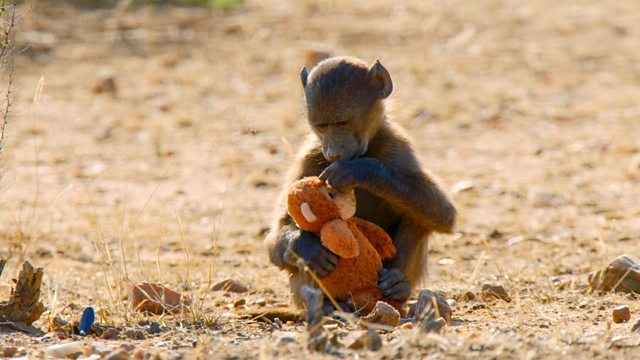
Playing Together
Some animals love nothing more than group games. But are they just for fun? This film uncovers the astonishing benefits they gain from playing together.
Around the planet, animals play all sorts of group games, from dolphins that play catch to hyena games of tug of war. Scientists are now discovering that playing together can provide animals with all sorts of surprising benefits.
Dolphins are renowned for being some of the most playful animals on the planet, and a population of Atlantic spotted dolphins from the Bahamas certainly live up to their reputation. Youngsters play high-speed games of chase. It helps the dolphins learn how to co-ordinate their growing bodies. The adults prefer something a little more sophisticated - collaborative games of catch the seaweed. As well as giving their big brains a work out, it is thought to help the pod unite and maintain strong social bonds.
For some animals group play can lead to friendships that last a lifetime. To cope with the challenges of living in large societies, one of our closest living relatives, the chimpanzee, uses play to work out who they can trust within the troop. There are many occasions in the life of these highly intelligent primates when they need to work together – to find food for example. If conflict breaks out, they also need to know who’s got their back.
The primate order is made up of over 500 different species and are among the most socially complex members of the animal kingdom. But research suggests that their position within their group and even their sex can determine the games they play.
A troop of playful chacma baboons is given a selection of new toys to play with. This experiment sheds light on an age-old question that surrounds human behaviour: are males and females biologically programmed to play in different ways or are the differences that we see a result of social influences from parents and peers? The results are striking. The male baboons go for the active toys, like the trucks. The females go for the dolls. While it is unlikely they recognise them as trucks and dolls, it suggests that in human children toy preference likely does have an innate component.
So, group play can help animals work out who their friends are, and it can be affected by the sex of an animal, with males and females often playing very different games together. Such play can also appear chaotic and lawless to the untrained eye, but scientists are discovering that for some species it is in fact governed by a set of strict rules that, if breached, can be life threatening.
For wolves, African hunting dogs and coyotes, play can be a boisterous, noisy and aggressive affair. There is a code of conduct that can’t be broken if they are to avoid hurting or even killing each other. And canines who don’t adhere to that code risk being ostracized. One study of wild coyotes found that individuals who violate the rules of play are shunned by the pack and are four times less likely to survive.
Not all boisterous animal play is noisy though. Black bear cubs are almost completely silent when they playfight together. But why? Scientists think this silent play has evolved to avoid attracting unwanted attention because young bear cubs are surprisingly vulnerable. At the first sign of danger, they instinctively climb trees to safety. It’s a reaction that’s triggered by the release of stress hormones. It’s vital that they learn to recover from that stress in order to feel safe enough to come back down again. Play fighting as cubs gets them used to experiencing stress in small and frequent doses, which makes them more adept at recovering from it as adults.
In animal species governed by a strict hierarchy, group play is the one occasion when those rigid social barriers can be broken down which can be a welcome relief to the more marginalised members of the group. Spotted hyenas live in one of the most brutal societies in the animal kingdom, and life can be particularly tough for cubs at the bottom of the pecking order. New research is finding that play can offer a moment of respite for them. Scientists think it may be vitally important for the survival of the clan – uniting all of its members.
For some animals, play behaviour is quite simply contagious.
In the mountains of New Zealand, flocks of kea parrots enjoy nothing more than pulling tourists' cars to pieces. Scientists have noticed that their playful antics appear to be contagious - where one plays, the others follow. But how do they communicate their intention to play? Their secret could lie in their ‘play call’, which encourages other nearby parrots to join in with the fun and games. It can allow keas to flit from flock to flock and coexist peacefully.
Throughout the animal kingdom, playing with others comes with huge benefits, building trust and lifelong friendships. It helps groups of animals to unite despite their social position and achieve more as a group than they ever could alone. For many animals its crucial to their success in the wild and even their survival.
Last on
More episodes
Previous
Next
You are at the last episode
Clip
-
![]()
Play bows
Duration: 01:22
Credits
| Role | Contributor |
|---|---|
| Narrator | Gordon Buchanan |
| Executive Producer | Alex Williamson |
| Series Producer | Laura Whitley |
| Director | Dan Perowne |
| Production Company | Offspring Films |
Broadcasts
- Sun 4 Aug 2019 20:00
- Sat 10 Aug 2019 13:30
- Sun 24 May 2020 18:15�������� Two except Wales & Wales HD
- Fri 16 Jun 2023 15:30

